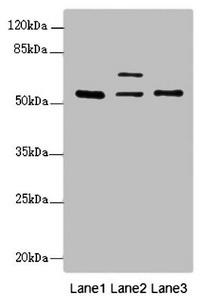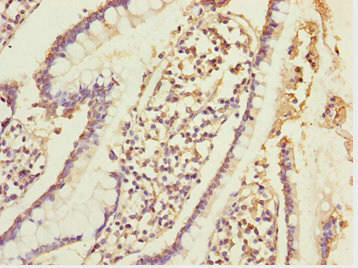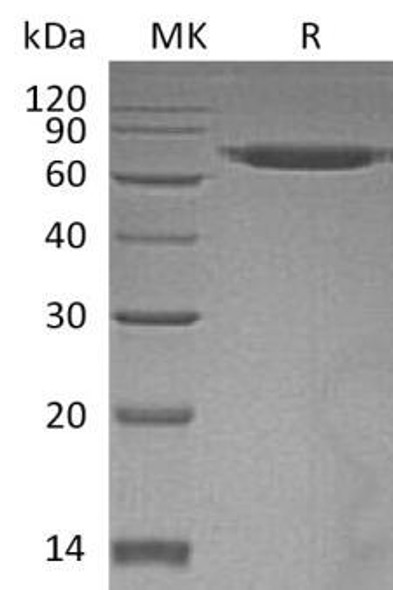Description
| Antibody Name: | ERO1A Antibody (PACO44633) |
| Antibody SKU: | PACO44633 |
| Size: | 50ul |
| Host Species: | Rabbit |
| Tested Applications: | ELISA, WB, IHC |
| Recommended Dilutions: | ELISA:1:2000-1:10000, WB:1:1000-1:5000, IHC:1:20-1:200 |
| Species Reactivity: | Human |
| Immunogen: | Recombinant Human ERO1-like protein α protein (24-260AA) |
| Form: | Liquid |
| Storage Buffer: | PBS with 0.02% sodium azide, 50% glycerol, pH7.3. |
| Purification Method: | Antigen Affinity Purified |
| Clonality: | Polyclonal |
| Isotype: | IgG |
| Conjugate: | Non-conjugated |
 | Western blot. All lanes: ERO1L antibody at 2.01µg/ml. Lane 1: HepG2 whole cell lysate. Lane 2: Hela whole cell lysate. Lane 3: MCF-7 whole cell lysate. Secondary. Goat polyclonal to rabbit IgG at 1/10000 dilution. Predicted band size: 54 kDa. Observed band size: 54, 62 kDa.. |
 | Immunohistochemistry of paraffin-embedded human small intestine tissue using PACO44633 at dilution of 1:100. |
| Background: | Oxidoreductase involved in disulfide bond formation in the endoplasmic reticulum. Efficiently reoxidizes P4HB/PDI, the enzyme catalyzing protein disulfide formation, in order to allow P4HB to sustain additional rounds of disulfide formation. Following P4HB reoxidation, passes its electrons to molecular oxygen via FAD, leading to the production of reactive oxygen species (ROS) in the cell. Required for the proper folding of immunoglobulins. Involved in the release of the unfolded cholera toxin from reduced P4HB/PDI in case of infection by V.cholerae, thereby playing a role in retrotranslocation of the toxin. Plays an important role in ER stress-induced, CHOP-dependent apoptosis by activating the inositol 1,4,5-trisphosphate receptor IP3R1. |
| Synonyms: | ERO1-like protein α (ERO1-L) (ERO1-L-alpha) (EC 1.8.4.-) (Endoplasmic oxidoreductin-1-like protein) (Endoplasmic reticulum oxidoreductase alpha) (Oxidoreductin-1-L-alpha), ERO1A, ERO1L |
| UniProt Protein Function: | ERO1L: Essential oxidoreductase that oxidizes proteins in the endoplasmic reticulum to produce disulfide bonds. Acts by oxidizing directly P4HB/PDI isomerase through a direct disulfide exchange. Does not act as a direct oxidant of folding substrate, but relies on P4HB/PDI to transfer oxidizing equivalent. Associates with ERP44 but not with GRP54, demonstrating that it does not oxidize all PDI related proteins and can discriminate between PDI and related proteins. Its reoxidation probably involves electron transfer to molecular oxygen via FAD. Acts independently of glutathione. May be responsible for a significant proportion of reactive oxygen species (ROS) in the cell, thereby being a source of oxidative stress. Required for the folding of immunoglobulin proteins. Responsible for the release of the unfolded cholera toxin from reduced P4HB/PDI in case of infection by V.cholerae, thereby playing a role in retrotranslocation of the toxin. Predominantly monomer. May function both as a monomer and a homodimer. Interacts with PDILT. Stimulated by hypoxia; suggesting that it is regulated via the HIF-pathway. Widely expressed at low level. Expressed at high level in upper digestive tract. Highly expressed in esophagus. Weakly expressed in stomach and duodenum. Enzyme activity is tightly regulated to prevent the accumulation of reactive oxygen species in the endoplasmic reticulum. Reversibly down-regulated by the formation of disulfide bonds between the active site Cys-94 and Cys-131, and between Cys- 99 and Cys-104. Glutathione may be required to regulate its activity in the endoplasmic reticulum. Belongs to the EROs family. |
| UniProt Protein Details: | Protein type:EC 1.8.4.-; Oxidoreductase; Secreted; Secreted, signal peptide Chromosomal Location of Human Ortholog: 14q22.1 Cellular Component: endoplasmic reticulum; endoplasmic reticulum lumen; endoplasmic reticulum membrane; intracellular membrane-bound organelle; membrane Molecular Function:disulfide oxidoreductase activity; oxidoreductase activity; protein binding; protein disulfide isomerase activity; protein disulfide oxidoreductase activity Biological Process: chaperone cofactor-dependent protein folding; protein folding; protein modification process; release of sequestered calcium ion into cytosol; response to reactive oxygen species; response to temperature stimulus |
| UniProt Code: | Q96HE7 |
| NCBI GenInfo Identifier: | 50400608 |
| NCBI Gene ID: | 30001 |
| NCBI Accession: | Q96HE7.2 |
| UniProt Secondary Accession: | Q96HE7,Q7LD45, Q9P1Q9, Q9UKV6, A8K9X4, A8MYW1, |
| UniProt Related Accession: | Q96HE7 |
| Molecular Weight: | 54kDa |
| NCBI Full Name: | ERO1-like protein alpha |
| NCBI Synonym Full Names: | endoplasmic reticulum oxidoreductase 1 alpha |
| NCBI Official Symbol: | ERO1A |
| NCBI Official Synonym Symbols: | ERO1L; ERO1-L; ERO1LA; Ero1alpha; ERO1-alpha; ERO1-L-alpha |
| NCBI Protein Information: | ERO1-like protein alpha |
| UniProt Protein Name: | ERO1-like protein alpha |
| UniProt Synonym Protein Names: | Endoplasmic oxidoreductin-1-like protein; Endoplasmic reticulum oxidoreductase alpha |
| Protein Family: | ERO1-like protein |
| UniProt Gene Name: | ERO1A |
| Antibodies |
| ERO1L Antibody (PACO09140) |
| Secondary Antibody |
| Anti-HRP Goat Anti-Rabbit IgG (H+L) Antibody (CABS014) |
| Recommended Products |
| Anti-FITC Goat Anti-Rabbit IgG (H+L) Antibody (CABS011) |
| Anti-HRP-conjugated Beta Actin Antibody (CABC028) |






